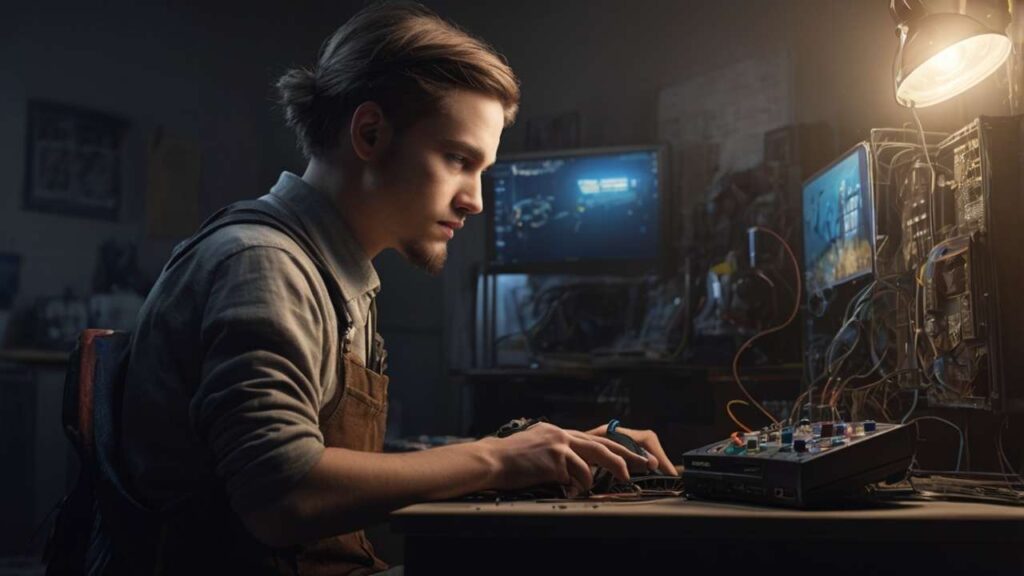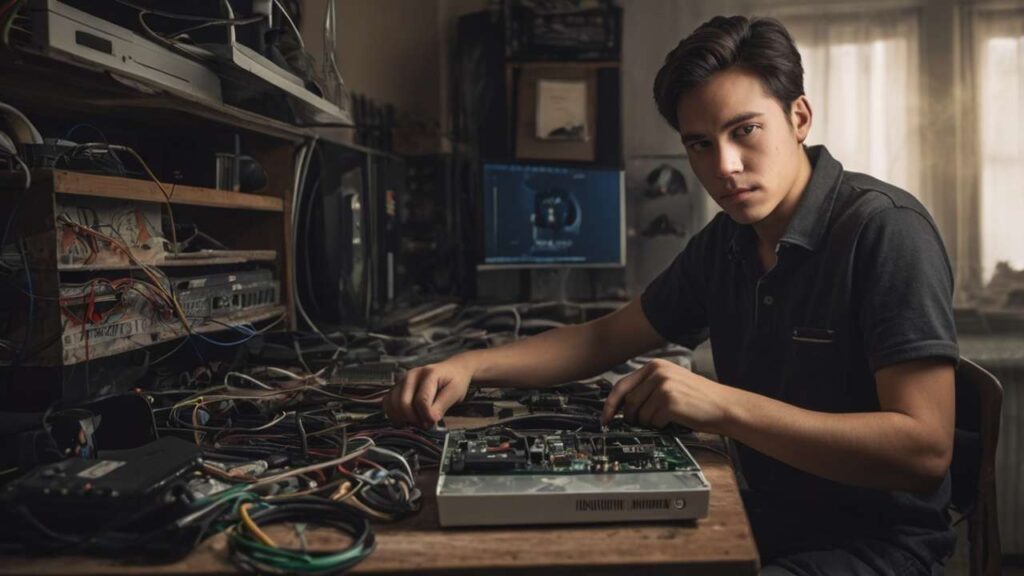There are few things more frustrating than powering on your PlayStation or Xbox, expecting a smooth gaming session, and being greeted by a black screen. The dreaded “No Video” issue has ruined countless weekends. Sometimes it’s just a loose HDMI cable, sometimes bent pins, but other times it’s far worse—HDMI port damage vs. easy fixes is where most gamers get confused. And if you end up on the wrong side of that diagnosis, the only way forward is often professional micro-soldering.
I’ll admit, I once thought I could “wiggle the cable” and solve the problem forever. It worked for a while, until one day the entire port collapsed inward. What I thought would be a quick fix turned into a two-week repair journey involving specialized tools like microscopes, hot air rework stations, and soldering irons finer than a pencil tip. That’s the difference between an HDMI cable issue and a fully broken HDMI port—one is solved in seconds, the other requires expert-level care.
Spotting HDMI Port Damage Symptoms
Not every black screen means you need a replacement port. Sometimes it’s just a cheap cable gone bad. Before panicking, try swapping out HDMI cords, and even test them on a different TV. However, if you notice these clear HDMI port damage symptoms, chances are you’ll need a repair:
- Loose connection that feels wobbly inside the port
- Bent or missing HDMI pins
- Port sinking into the console’s frame
- “No Signal” errors even with verified working cables
- Visual artifacts or flickering that never resolve
Professional technicians I’ve spoken with often say that DIY fixes here can make things worse. A bent pin isn’t just cosmetic—it can short out the motherboard if forced. And once traces on the board are damaged, repair costs skyrocket.
HDMI Cable Check vs. Physical Port Damage
The first step in the “No Video” issue is always elimination. Swap cables. Try different HDMI inputs on your TV. Sometimes the solution is laughably simple—cables fail more often than we like to admit. But if the same problem persists across multiple TVs and cables, you’ve got a deeper issue.
Here’s where the comparison matters:
- A new cable costs $10–$20.
- A professional HDMI port repair cost averages between $80–$150 for consoles like the PS4 or Xbox.
- For high-end consoles or ones with motherboard trace damage, it can climb beyond $200.
That difference is exactly why misdiagnosis can hurt your wallet.
Why Professional Micro-Soldering Matters
HDMI port replacement isn’t just about popping out the old connector and pushing in a new one. Each HDMI port is secured with micro-soldered joints smaller than a grain of rice. These joints handle high-speed video signals, so even the tiniest mistake causes total failure.
Professional repair shops use:
- Microscopes to see joints invisible to the naked eye
- Hot air rework stations for precision heating without frying surrounding chips
- Flux and solder paste formulated for delicate digital connections
- Multimeters to confirm continuity on every pin
I once watched a trusted technician work on an Xbox HDMI port, and the level of detail was astonishing. What looked like chaos under the naked eye became precise engineering under a microscope. That’s why professionals warn that DIY HDMI repair carries huge risks. One slip and you can destroy the motherboard entirely.
For reliable solutions in North Carolina, see the best gaming console repair recommendations. These experts specialize in micro-soldering, making them your safest bet.
Case Study: The PS4 No Video Fix
Take the PS4, a console notorious for HDMI failures. A friend of mine had the classic “no signal” problem. At first, we assumed the HDMI cable was faulty. After testing multiple cords and televisions, the verdict was clear—the HDMI port pins were visibly bent.
He debated trying a DIY repair kit from Amazon, but the technician at his local shop warned him: “Fixing HDMI pins isn’t like replacing a car battery. It’s more like performing eye surgery.” He reluctantly agreed to a professional repair. Within three days, the port was replaced with a brand-new OEM connector, tested across multiple monitors, and guaranteed with a 90-day warranty.
The bill? $120. Expensive compared to a cable, but far cheaper than buying another PS4.
Xbox HDMI Port Replacement
The Xbox One and Series X also suffer from HDMI port issues, especially after accidental yanks when someone trips over the cable. Replacement costs are similar to the PS4, but the challenge lies in the motherboard layout—tighter, smaller, and less forgiving.
One technician explained to me that micro-soldering here requires steady hands and practice. “I’ve seen DIY jobs where people used hardware store soldering irons and literally melted half the board,” he said. “You can’t brute-force this repair. It takes patience and the right tools.”
That insight highlights the risk—Xbox HDMI port replacement is possible at home, but you’re rolling dice with expensive hardware.
DIY HDMI Repair Risk
The internet is filled with videos of people attempting HDMI repairs with $20 soldering kits. While some succeed, the failure rate is high. Without a microscope, you can’t even see the quality of your solder joints. Without flux and controlled heat, you’re likely to bridge connections or cook nearby components.
Professional micro-soldering services exist because these repairs are not meant for hobbyists. Yes, you might save a buck attempting it yourself, but the downside is a fried motherboard and a console that’s now worth nothing.
For those serious about prevention, reading resources like 5 Simple Habits to Double Your Console’s Lifespan can help avoid HDMI and thermal failures entirely.
Beyond HDMI: Other Console Repair Realities
HDMI ports aren’t the only fragile points. Consoles often need thermal paste replacement and fan cleaning. Anyone who’s heard their PS4 roar like a jet engine knows what I’m talking about. Articles like The Jet Engine Console: Signs You Need PS4/Xbox/Switch Thermal Paste and Fan Cleaning cover this in detail.
Other issues include USB-C charging faults on the Nintendo Switch, often caused by M92 chip failures. A deep dive into USB-C and M92 repairs explains how even small components can cripple an entire console.
Looking ahead, broader topics like “repair or replace” decision-making and cost-benefit analysis will continue to shape the conversation. With console prices climbing, extending lifespan through trusted, expert repairs becomes more than convenience—it’s financial survival.
Future Directions in Console Care
It’s not just HDMI ports and thermal paste that matter. The future of console repair will likely explore sustainability, eco-friendly part sourcing, and advanced diagnostics. I expect more conversations around predictive AI that flags failing components before they crash. Imagine your console alerting you: “Your HDMI port pins are stressed—service soon.”
Gamers are also asking about preventive maintenance plans, something rarely offered but increasingly in demand. Subscription-style care, covering micro-soldering checks, cleaning, and board inspections, might become the norm.
And let’s be honest—topics like “console data recovery after board damage” and “custom cooling solutions for extended lifespan” aren’t just theoretical. They’re the next wave of questions repair shops will answer. For now, browsing the gaming console repair category is a great way to stay updated.
FAQs
1. How much does HDMI port repair cost for consoles?
On average, $80–$150 depending on the console and damage severity. More if motherboard traces are involved.
2. Can I fix an HDMI port at home without professional tools?
Technically yes, but it’s risky. Without a microscope and proper soldering station, the chance of permanent damage is high.
3. How can I prevent HDMI port damage in the first place?
Avoid yanking cords, use angled HDMI adapters, and keep cables supported to reduce stress on the port.
The battle of HDMI port damage vs. easy fixes comes down to knowing the difference between a $10 cable swap and a $150 micro-soldering repair. Gamers often gamble with DIY methods, but the truth is that professional tools and expertise are the only reliable path for long-term fixes.
So, if your console is showing “No Video,” don’t panic, but don’t procrastinate either. Test your cables, confirm the symptoms, and if needed, trust a professional repair shop. After all, keeping your console alive isn’t just about saving money—it’s about protecting the hours of joy, progress, and memories stored inside it.
If you found this guide helpful, share it with your gaming friends using the buttons below. You might save someone from turning a simple fix into a permanent disaster.


